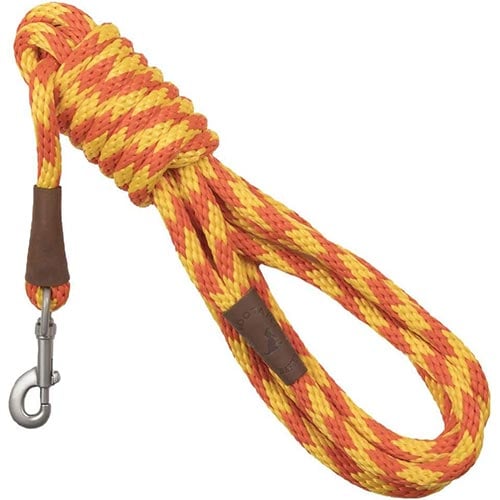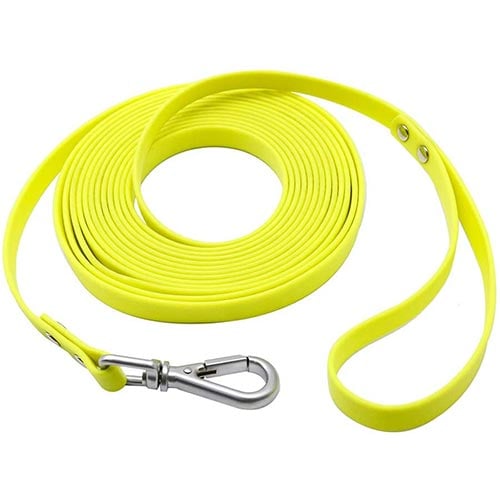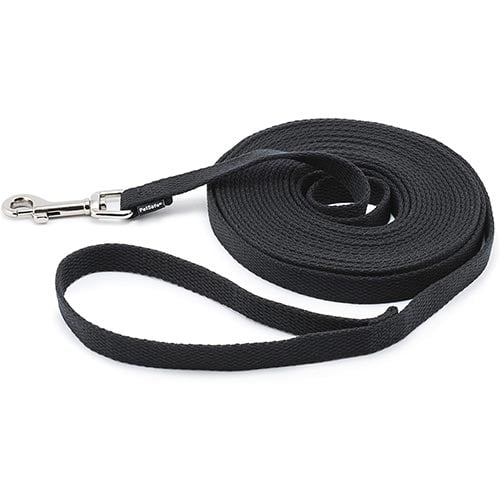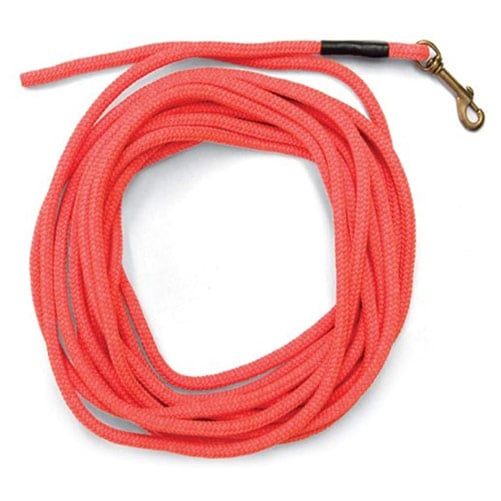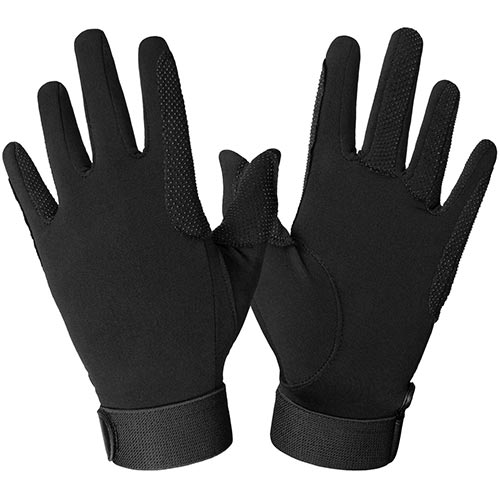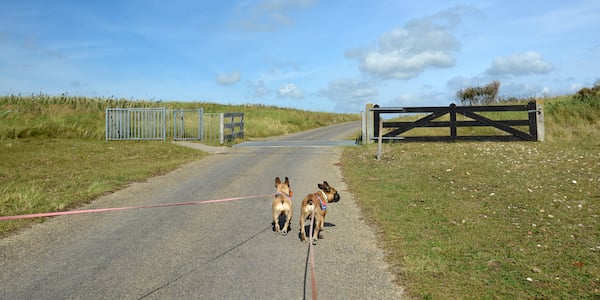 One of my favorite tools in dog training is the long leash. In fact, I have four different long leashes that I use regularly. It allows me to work on reliable recalls, and long-distance stays, and is especially useful with practicing loose leash walking.
One of my favorite tools in dog training is the long leash. In fact, I have four different long leashes that I use regularly. It allows me to work on reliable recalls, and long-distance stays, and is especially useful with practicing loose leash walking.
Plus, it gives my dogs more freedom to follow their nose when we go on sniffaris or go on a hiking trip, while still keeping them safely attached to me. It's perfect for dogs who may not be ready to be off-leash or for areas where dogs are required by law to be on a leash (which is almost everywhere!).
Table of Contents
There are quite a few benefits to using a long lead with your dog, but it's important to know how to use it safely for both you and your pup.
Like many other dog trainers, I am not a fan of retractable leashes, which makes long leads my go-to option. There are too many safety risks that come with using a retractable leash, and Flexi leashes can also hinder loose leash walking training. The constant tension of the retractable leash teaches a dog that they need to pull against leash pressure in order to move forward. This can make walking on a regular leash without pulling hard for them to understand. While handling a long lead may feel awkward at first, it's worth the switch from a retractable leash.
What Are Long Leashes for Dogs?
Long leashes are simply longer versions of regular-length dog leashes, ranging from 10 to even 100 feet in length. Long leads come in a variety of materials. Options include climbing rope, cotton, or flat nylon.
A rope-style of long leash is very sturdy (as long as your pup isn't allowed to chew on it), but if it's a thinner width it can cause rope burn easily. Look for a rope leash that is soft and pliable. My absolute favorite long leash and the one I use most frequently is the Mendota long leash, which is 15 feet long and available in two widths, 3/8 inches for smaller dogs and 1 inch for larger dogs.
A popular long leash material is biothane, which is lightweight, waterproof, and easy to wipe clean. I personally don't love the feel of biothane in my hands, but many dog owners don't mind. If you're walking your dog in inclement weather most of the time, this can be a great choice because it's so easy to clean.
Cotton leashes are less likely to cause rope burn, but get wet and dirty very quickly since they absorb water. They are, however, one of the lightest materials available for long leashes when dry.
Flat nylon has sharper edges on the leash, which can be uncomfortable to let slide through your palms, and gets heavy when wet. My flat nylon long leash (purchased at Petsmart) has adjustable loops, meaning I can change how long I want it depending on when and where I am. I especially like it for my older dog's sniffari walks, which you can see in this video:
Some long leashes are called check cords, which don't include a handle loop at the end. Check cords are meant to be dragged behind a dog, such as during scent tracking or other work. Without a handle loop, it is less likely to get caught on brambles, sticks, rocks, or other terrains that would hinder the dog's work.
Another bonus use of a check cord is using it to teach a dog to fetch! If they aren't super reliable about bringing back the fetch toy quite yet, attaching the long leash to the toy means you just need to reel it in if your dog loses interest. This works really well with training fetch or retrieves in the water, as you can see one of our Preventive Vet team members doing with their Portuguese Water Dog using a KONG Float Toy in the photo below:
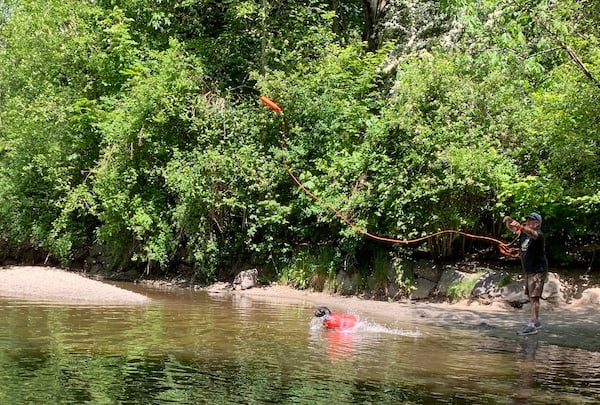
Choosing the Right Long Leash for Your Dog
Start Short
When you first start practicing with a long leash, choose a shorter length so you can get comfortable with handling it. 10 or 15-foot-long leads are a great starter option. In fact, 15-foot lengths are what I like using for loose leash walking training. As you get familiar with handling more leash than usual, and your dog starts to understand their newfound freedom of movement, you can move up to longer lengths.
Comfortable to Hold & Easy to See
You'll want a long leash that's comfortable for you to hold onto and let loosely move through your hand as your dog moves further away from you. Flat nylon leashes tend to have sharper edges than climbing rope or biothane. Choosing a bright color can be helpful so you can see where the long lead is while your dog is dragging it.
The Right Weight for Your Dog's Size
The last thing you want is for your Chihuahua to be dragging a heavy and thick long leash or for a Great Dane to snap a thin long leash. Match your dog's size, weight, and power with the long leash material and thickness. The wider the long leash, the heavier the leash clasp needs to be.
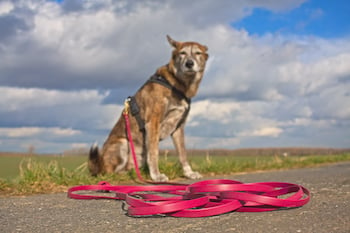
How to Use a Long Leash Safely
Only Use a Long Leash Attached to Your Dog's Harness
When walking your dog on a long leash, attach it to the harness ring on your dog's back. This helps prevent any jerking on their neck or twisting of their body if they run to the end of the long lead at higher speeds. The ultimate goal with long leashes is to not have a dog rush to the end of the lead, keeping it loose or dragging for the entire time it's in use.
Avoid Leash Burn
Rope burn hurts! Leashes can cause injury to your hands or legs if they are gripped too tightly while sliding through or wrapped around your ankle or foot and quickly pulled across the skin as your dog moves away. Trust me, it's not something you want to experience.
The best way to avoid getting a leash burn on your hands is to wear gloves when handling a long leash. Wear long pants and avoid wearing sandals or open-toed shoes when out on a long lead walk with your dog. I've found that equestrian riding gloves work the best for my needs. They're comfortable and form-fitting, allowing me full dexterity so I can easily handle the leash, let it flow through my palms as the length extends, and grab treats when needed for training. I personally use the FitsT4 gloves below.
If you prefer not to wear gloves, you have the choice of either firmly gripping the leash (risking rope burn), dropping it, or stepping on it to bring it to a stop. Ideally, use gentle stopping pressure on the leash before a dog is running full tilt.
Learn How to "Lock" the Leash
Learning a leash lock is extremely helpful for long leash handling. A leash lock is a grip that prevents the leash from slipping through your fingers or from your hands. It's a stronger hold that also helps prevent injury and prevents your dropping the leash. There are two types to choose from, a thumb lock or a finger lock.
This video shows how to use both types of leash locks. Practice with your regular leash first before practicing with the long leash!
How Not to Trip on a Long Leash
Keep excess leash length wrapped up in loose loops as needed. As you get closer to your dog when they are in front of you, pull in the length by reeling it in. As they move away, release loops to allow for more distance.
Another option is to allow the excess length to drag behind you, moving your hands up the leash towards your dog rather than looping extra length.
Always be aware of what side of your body the leash is on! If the length is on the right side of you and your dog moves to your left, ensure that you've stepped both feet over to the correct side so that the leash is never between your feet. If I have a hold on the leash and my dog loops around me in a circle, I simply do a 360 myself to prevent from getting wrapped up, rather than switching the leash between hands. It's a lot like dancing!
The Leash Belay
Grisha Stewart, a fantastic trainer, has developed a wonderful way to use a long leash safely. I especially love her technique for large dogs paired with smaller people, those with shoulder or arm injuries, or those that want to operate a long leash with one hand only. This belay system also provides for a much slower braking system that reduces the force of a stop on both the handler and the dog.
Check out this technique in Grisha's video below. Along with a rope long leash, you'll need a sturdy waist belt and the leash belay hardware kit.
Be Aware of Other People!
It's best to only use the long lead in areas without a lot of foot traffic. You don't want to clothesline or trip someone up someone by accident! Reel in the leash to a manageable length of four to six feet when approaching other people. If by accident the leash starts to wrap around someone, drop as much length as you can so it doesn't tighten around their feet or legs. Grab the leash as close to your dog as possible to stop movement before extricating someone from the rest of the leash.
Practice, Practice, Practice
Using a long lead takes some practice to find the most comfortable and safe way for them to manage the longer length. You'll find that having a long leash benefits your training practice and gives your dog more freedom while staying safe!


